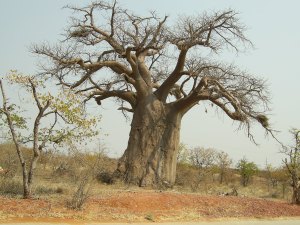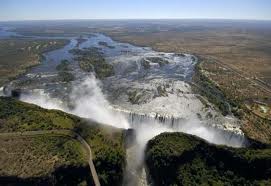We’re visiting Zimbabwe at a time when they’ve just had general elections, and President Robert Mugabe has just been elected for an 8th term as President, amidst allegations of voter irregularities.
I have only ever visited Zimbabwe once to attend a conference, and spent my entire time there closeted in meetings at the capital Harare, so I cannot recount any personal experiences of the country.
Our information for our study is therefore mostly thanks to Wikipedia …
We learn that Zimbabwe has formerly been known as Southern Rhodesia, Rhodesia, and Zimbabwe Rhodesia. The first recorded use of “Zimbabwe” as a term of national reference was in 1960, when it was coined by the black nationalist Michael Mawema, whose Zimbabwe National Party became the first to officially use the name in 1961.
The name “Zimbabwe” is based on a Shona term for Great Zimbabwe, an ancient ruined city in the country’s south-east whose remains are now a protected site.
The country has 16 official languages, with English, Shona and Ndebele being most common.
The country is mostly savanna, although the moist and mountainous east supports tropical evergreen and hardwood forests. Trees include teak and mahogany, knobthorn, msasa and baobab. Among the numerous flowers and shrubs are hibiscus, spider lily, leonotus, cassia, tree wisteria and dombeya.
There are around 350 species of mammals that can be found in Zimbabwe. There are also many snakes and lizards, over 500 bird species, and 131 fish species.
Some fun facts about Zimbabwe:
- Zimbabwe was ruled over by Mutapa Empire, renowned for its gold trade routes with Arabs, but the Mutapa Empire was destroyed by the Portuguese in the 17th century. In 1834, the Ndebele people arrived in Zimbabwe, making it a new empire, known as Matabeleland. In 1880s, the British arrived and the name Southern Rhodesia was adopted in 1898. In 1980, the country attained independence, along with a new name – Zimbabwe.
- Victoria Falls in Zimbabwe are locally known as Mosi-oa-Tunya, “the smoke that thunders,” and they are the largest waterfalls in the world. See video http://www.youtube.com/watch?v=96-CibrZ3Vw
- Mapungubwe, located in present-day Zimbabwe, was the largest ancient kingdom in the sub-continent, before it was abandoned in the fourteenth century.
- Lake Kariba, constructed on the Zambezi River, is one of the world’s largest manmade lakes in the world.
We round off our Zimbabwe study with a traditional Zimbabwean meal of Sadza and Dovi.
Sadza (Cornmeal Porridge)
The cornmeal-based dietary staple of Zimbabwe is the national dish. Sadza is to the Zimbabweans what rice is to the Chinese or pasta is to the Italians. “In fact, sadza re masikati, or ‘sadza of the afternoon’ simply means lunch. Sadza re manheru, or “sadza of the evening” means dinner. Sadza is made from cornmeal or maize and eaten with relish. ‘Relish’ can be any kind of vegetable stew, but nyama (meat) such as beef or chicken is common among families who can afford it. Sadza is cooked slowly until thick, like porridge.”
Ingredients
- 4 cups water
- 2 1/2 cups cornmeal
Instructions
Bring 3 cups of the water to a boil in a large pot. Combine 1½ cups of the cornmeal with the remaining 1 cup water. Reduce heat to medium to low and add the cornmeal mixture to the boiling water, stirring constantly with a wooden spoon. Cook for about 5 minutes. Slowly adding the remaining 1 cup of cornmeal. When the mixture is very thick and starts to pull away from the sides of the pan, transfer to a serving bowl or plate. Use a wooden spoon to shape the mixture into a round shape. You may use wet hands to help shape the sadza . Serve with stew. (This recipe & info came from cookeatshare.com.)
Dovi (Zimbabwe Chicken Stew)
Ingredients
- 2 medium diced onions
- 2 tablespoons butter
- 2 minced garlic cloves
- 1 teaspoon salt
- 1/2 teaspoon pepper
- 1/2 teaspoon cayenne pepper
- 2 chopped green bell peppers
- 1 1/2 lbs boneless chicken breasts cut into bite-size pieces
- 3 tomatoes (or more to taste)
- 6 tablespoons peanut butter
- 10 ounces frozen spinach (or 1/2 pound fresh)
Instructions
Cook onions with butter on medium-high heat in a big stew pot until browned. Add garlic, salt and seasonings. Add the green peppers and chicken. And cook until chicken is no longer opaque. Add the tomatoes and mash to soften. Add about 1 1/2 cups water (or use broth if you like) and simmer for about 10 minutes. Add half the peanut butter to the pot, reduce heat, and continue to simmer about 5-10 minutes. Add the rest of the peanut butter and the spinach into the pot. Stir all together and simmer 5-10 minutes more.(This recipe came from food.com.)
Next: (The posting of this article was delayed due to a fabulous holiday in Mauritius) Next up therefore – MAURITIUS!


Reblogged this on http://www.newsafrica.co.uk.
You should really come have a look for yourselves. Its a beautiful place
I believe it is, and definitely on my bucket list!